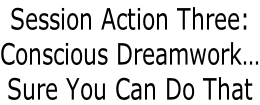The dream world is alive. It is not a manifestation of late night pizza. There is nothing random about it. It is a natural offshoot of the fluctuation of brain waves and the ever present connection with our own higher Self, where we are in evolving relationship to remember and reclaim who we are by design. Dreams are, then, a profound mechanism whereby we can clear, clean, and redirect energetics for the purpose of keeping us on the path of going and getting home to our own infinite truth.
Suffice it to say that many, if not most, see the dream world as a mystery, a place that can be even dangerous, a place that is best left alone, or conveniently forgotten at the first blush of consciousness. This is way short of the mark. We have within us a recurring process that delivers wisdom and insight and inspiration while at the same time it cleans the inner woodwork of energetic dust bunnies.
It was Carl Jung who opened the door to the dream world as rich in imagery and open to conscious interpretation to be used as a reliable guide to our moment of living as well as our own big picture. When you pair his spiritual approach to the fantastic interconnected world within each of us with the societal bowing to needing scientific proof at any cost, you see we are each pushed and pulled to find, at best, our own relationship. That relationship begins with letting go of fearful thinking and opening up to an inner knowing that, despite how much we have been and learned to be restricted and limited, we are each still captain of our own ship.
The dream state is a processing arena for the unprocessed during the waking hours. The more one tends their own energetic clarity by releasing emotional residue, unspoken wounds and words, and unsolved problems, then the more one will be free to frolic in the dream world. The dream state is also the place where we can access fourth and fifth dimensional energies to get on with exploration and expansion. Here you can access dimensional classrooms to learn the latest. It is where you can tether yourself to your physical navel and then fly about in a whimsical exploration of unrestricted freedom. It is where you can find solution through the magic of serial dreaming, which repeats a scenario but allows evolution towards resolution. It is where you can get to know the multidimensional landscape and put new ideas in action. It is where you can visit those who have passed on, where you can gather with like frequency communities, where you can interface with any historical figure, where you can have a roundtable with your own Higher Self and Source. It is where you can choose the paths that will manifest in physical form…and, oh, so much more.
Do you consider any or all of this to be possible? The answer to this is your launch point. What you get will be based on your openness. Your free will capacity can override any design element. As you wish, the Universe says. So, let’s get clear by reflecting a bit:
1. On a piece of paper list everything you bring to the belief table about dreams
2 Now list your personal experiences of dreams
3. Make a list of nightmares you remember
4. Make a list of “pleasant dreams” you remember
Read back through them all. What do you get is your overall openness to the dream world? This is a critical point for you in terms of working with your dreams. Are you open to more? If not…then go make lunch and go shopping because this is not going to become anything but a nightly distraction. If you are open, then let’s start looking at and applying possibilities.
I am borrowing from a book, Conscious Dreaming: A Spiritual Path for Everyday Life, by Robert Moss. Here are some basics for becoming a dreamcatcher: (Please consider doing what he suggests)
1. Clearly state your intention to yourself. For example: “I want to remember my dreams tonight.” Or: “I ask for the guidance of my dream source.” Reaffirm your intention when you lie down to sleep. You may want to write this down as a statement or request and put the piece of paper on your bedside table or under your pillow. If you have fairly good dream recall already, or if there is a major concern you need to explore, you may wish to formulate a more specific request. For example: “How can I be healed?” Or: “How can I best handle the job interview?”
2. Have your tools ready. Put a notepad and pen (or a tape recorder, if you prefer) on your bedside table where you can reach them easily without having to grope around or turn on the light.
3. Give yourself time to bring your dreams back. Allow yourself some extra time in the morning to laze in bed and let your dreams come back to you. It’s best if you can wake spontaneously, without an alarm. If you must use an alarm clock, set it to a buzzer rather than the radio, so you don’t get caught up in the clutter of the outside world as soon as you wake. If you are new to dreamwork, you may want to start your experiments over a weekend or a vacation break when you can set your own schedule.
4. Give yourself space. Try to record your dreams before getting out of bed. Try using a penlight if you find you can’t write in the dark and do not wish to disturb your partner. If necessary, creep into the bathroom to jot down your notes; a lot of good dreamwork begins in the bathroom.
5. Write your dreams down at once. This may seem like cruel and unusual punishment when you wake from a dream at 4 A.M., but dreams are fleeting, often gone within minutes if you release your attention. Furthermore, the most powerful and urgent dreams often come at inconvenient times. If you tell yourself you can go back to sleep and catch them later, you’ll probably find you are wrong.
6. Start with a few trigger words. You can use these later to produce a fuller report. The dream scene you remember most clearly is probably the one from which you have just woken. Summarize it in a few words. Make sure you include any names and phrases you recall. You may find yourself triggering memories of earlier scenes. Write these down, too. Your notes will often give you a dream sequence in reverse order, like a movie run backwards. You can correct this when you write a finished report in your journal.
7. Don’t censor your dreams! The dream source can be brutally frank about aspects of your personality, behavior, and desires you prefer to ignore or repress. Let it speak! It knows you better than you know yourself in your everyday mind.
8. Don’t interpret! Concentrate on capturing your dream experience raw before you start worrying about what it means. Don’t reject dream material as “weird” or “trivial.” A dream that seems bizarre may be dramatizing an issue in order to grab your attention, or guiding you beyond your normal level of awareness. A mundane-seeming dream may contain important precognitive material; much of waking life is also ho-hum.
9. Pay attention to your feelings. Your feelings about your dream are often your best guide to its meaning and urgency. The storyline may seem banal, but if you have strong feelings about the dream, there is something here you need to work on. Pay attention to your physical sensations as well. Dreams are bodytalk as well as soultalk.
10. If you wake with no dream memories, relax. Roll around gently in bed. Sometimes dreams are coaxed back when you get your body back to the position you were in when they originally came to you.
11. Put out a welcome mat. If you still have no dream recall, take a moment to write down what you are thinking and feeling. Your thoughts and sensations may be part of your dream hangover, even if you have lost the dream. By writing something down, you are putting out a welcome mat for tomorrow’s dreams. You are signaling that you are at home and ready to receive. You may notice, as you get into the swing, that there are cycles to your dream recall. For example, some women report heightened dream activity during their periods and around the full moon; others experience a blackout effect.
12. Always do something with your dreams. Keeping a journal is a first step. Sharing with a partner is great home entertainment and will help sustain your commitment to catching and working with dreams.
Moss, Robert. Conscious Dreaming (pp. 42-43). Potter/Ten Speed/Harmony/Rodale. Kindle Edition.
This is the beginning of conscious dreaming. Create the space to experience the expansive nature of this kind of work. Interpretation of dreams is always best served by you, rather than a dream interpretation book. Sure, according to Jung and 6th dimensional paradigms, there are archetypal images that have universal meaning. But, the context with which they arrive is all in your hands. Know also that characters and situations in dreams may have to do with your possible future experiences from which you can bring back insight, strategies, and inspiration. Please do not underestimate the importance and potential of your own journaling as you are able to monitor personal health, your relationships, and progress toward or away from bigger goals, among so much more…In regards to the journaling: 1) Choose the right book for you; 2) Keep your journal private; 3) Do it first thing in the morning, if possible; 4) Date your entries; 5) Give your dreams titles; 6) Note your feelings and immediate associations; 7) Keep a running index of dream titles; 8)Note recurring themes and locales; 9) Log correspondences between dreams and waking events. Above all, make this an enjoyable revealing experience that you know is assisting you to live consciously in creating and embracing your life in the now.
As a side note, nightmares are unresolved dreams, aborted before the resolution was arrived at. The energetic stirrings manifest in forms that get action…if we allow it. Knowing that you want to see what is on the other side of the “monster” will allow you to be fully present in the chaos. Sometimes the actions are obvious. Chased? Then ask what am I running from? In other words, do all you can to stay with the dream. The more versed you become in working with the dreams, then the more able you are to make conscious choices mid dream. Dialogue with your fears to get insight. Dialogue with a dream adversary. Rescript the role of your dream self and rewrite the outcome. Invoke allies and support in the dream. You can even ask, “Why are you in my dream?” Or “What are you telling me?” Developing the idea that dreams are not necessarily to interpret but, rather, to tap into the dream energy and bring it into waking life.
I invite you to look through this section several times, re-read your own reflections of dreams and start to journal your dreams for a period of time.
I am adding another focus on working consciously with dreams with a variety of additional techniques to experience. I do recommend the books of Robert Moss as they are excellent resources and textbooks for getting the most from your nightly dream experiences.
For now, get to sleep…perchance to dream

